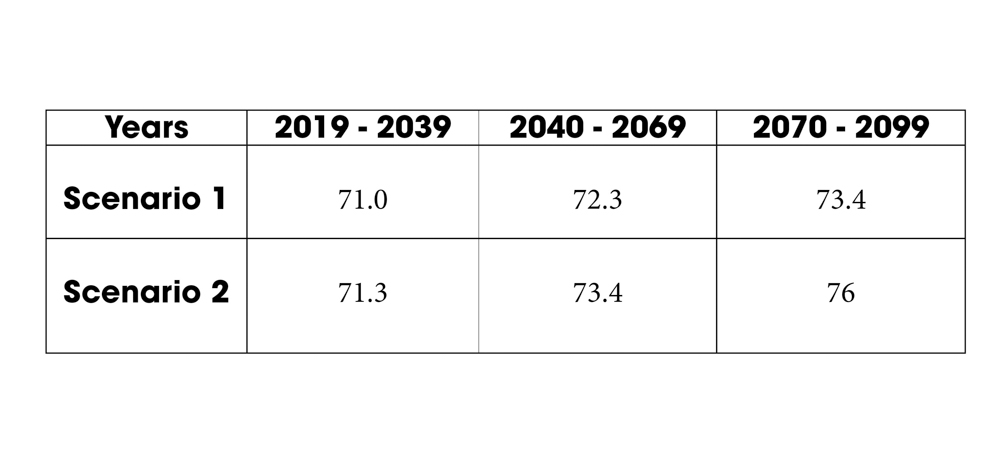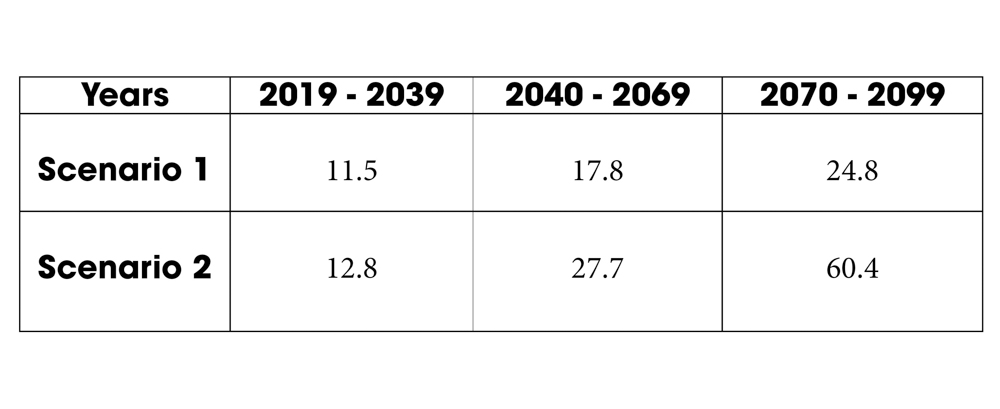Statistics: How Hot, How Wet, and for How Long
Combined Higher Temperatures, Santa Barbara Can Expect Both Drought and Flooding

How much will the county be affected as the globe grows warmer? Different scenarios were explored in California’s most recent climate assessment — from wildfire to the oceans — including a look at temperature and rainfall. Researchers used data for the latter two from 1961 through 1990 to project likely outcomes from the carbon gathering in the atmosphere.
For Santa Barbara, the maximum temperature averaged 68.8 degrees Fahrenheit countywide for 1961-1990; the average minimum was 43°F. By 2100, both the maximum and minimum temps rise by about 7 degrees if no preventive measures are taken to contain greenhouse-gas production (Scenario 2). If strenuous prevention occurs and GHGs plateau in 2040, hot days are still hotter, and so are cold days, but this time by about 4 degrees (Scenario 1).
Maximum Temperature (avg. 68.8°F, 1961-1990)
1991-2005; 69.4
2006-2018; 70.4

How many days will it be hotter than before? The county experienced roughly 4.3 days of an average 87.5°F of heat in past decades. That goes up to 33 heat days by 2100 if atmospheric carbon rises unchecked, and 17 if it begins to back down in 2040.
The results were developed by researchers at Scripps Institution of Oceanography’s Climate Research Division, a group that’s been around for decades. It’s currently led by Dan Cayan, a widely recognized expert in the field; he and Climate Research Division scientists Julie Kalansky and David Pierce ran the numbers. They used 10 climate models — among them Australia’s CSIRO (Commonwealth Scientific and Industrial Research Organisation); the National Center for Atmospheric Research in Boulder, Colorado; and others from Great Britain, Japan, Italy, and France — to arrive at a look at climate 80 years from now.
“The results are called ‘projections’ not ‘predictions’ because they depend on how much greenhouse gas gets released to the atmosphere in the future,” explained Dr. Pierce. “That depends on things like politics, technology advances, and economics, which climate scientists do not pretend to predict.” The group supplied two scenarios for California’s Fourth Climate Change Assessment (climateassessment.ca.gov), one in which society reduces greenhouse gas emissions in the future and one in which nothing is done. “You can see the effect that such decisions have on the Earth’s future warming,” Pierce said.
The assessment is full of statistics, missing only perhaps the number of hotter nights the future holds, an important factor in heat-related deaths. Pierce ran the question through their computer for the Independent, arriving at a simple average. In the past, the county had just over four days of above-minimum temperatures of 57°F or more. With no mitigation, that goes up to 60 hot nights by 2100, and 25 if GHGs are reined in.
Average Number of Nights Above Minimum Temperature (avg. 4.3 nights above 57°F, 1961-1990)

Rainfall, which averaged 17.6 inches in the recent past, was projected to be 21.5 inches by 2100 with unrestrained emissions; it’s 18.9 inches if contained. Though both projections increase Santa Barbara County’s rainfall, the fine print actually contains fewer wet days and more dry days, which means the rain will fall faster and harder. Combined with the higher temperatures forecast, the county can expect both drought and flooding in the near and distant future.



